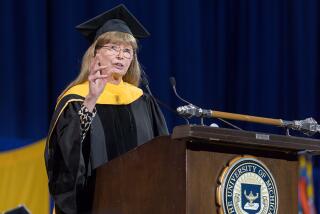THE CUTTING EDGE: COMPUTING / TECHNOLOGY / INNOVATION : Former Apple Executive Gassee Is Now Where He Wants to Be
- Share via
MENLO PARK, Calif. — For Jean-Louis Gassee, the road back to center stage has been long and hard.
Recently, Gassee, the former Apple Computer research and development vice president who had been something of a celebrity in the computer industry, re-emerged after nearly six years of seclusion. In typically grand style, he picked one of the computer industry’s most prestigious events--the Agenda conference, a kind of nerds’ Bohemian Grove--for his comeback.
Gassee showed the crowd that he had not been idle, taking the Agenda stage with a new computer and dazzling the crowd with a demonstration of vividly colored photographic images, lifelike video and stereo sound. The kicker is that the machine costs a mere $1,500.
The jaded audience jumped to its feet to give Gassee and his Be Box--named after his new venture Be Inc.--a standing ovation. And Gassee, in a rare show of humility, choked back tears.
“This is what the [Apple] Macintosh [computer] should have grown up and become,” says David Coursey, editor of PC Letter, an influential industry newsletter.
Sweet revenge for a man unceremoniously dumped by Apple.
Gassee was the right hand of Apple’s former Chief Executive John Sculley. For a time, the colorful Frenchman acted as Apple’s spokesman, filling a role left vacant by the ouster of charismatic co-founder Steve Jobs.
At first, Sculley was content to allow Gassee to bask in the spotlight. Unlike Sculley, who had come to Apple from PepsiCo, Gassee was a technologist who spoke the lingo of the computer crowd. Handsome, articulate and more than a bit arrogant, Gassee was the embodiment of the brash, young company.
In 1990, Sculley gave Gassee his walking papers: Perhaps the No. 2 had upstaged the top man once too often. Or, maybe the proud--and often irreverent--Gassee had failed to treat his boss with the deference Sculley expected of subordinates. (Rather than replace Gassee, Sculley took on the responsibilities of product development.) “John got tired of me, basically, so we decided to split,” Gassee says.
A handful of Apple’s engineers picketed the company’s Cupertino, Calif., headquarters to protest their boss’s firing. But few others mourned. When Apple was doing well, Gassee’s swagger charmed; when it struggled, it grated.
Gassee was blamed for one of Apple’s most painful mistakes: A portable computer so heavy that only a weightlifter could lug it. And, he opposed licensing the Macintosh’s popular software, something that analysts say would have allowed Apple to compete more effectively against PC software giant Microsoft Corp. and its now-dominant Windows software.
“Jean-Louis was not a particularly loved character in the computer industry,” confirms PCLetter’s Coursey. “When he was kicked out of Apple, a lot of people thought he had it coming.”
Although his years at Apple had made him a wealthy man, at 46, Gassee felt too young to retire. He toyed with a number of projects. “I tried to buy CompuServe for $400 million, but H&R; Block wanted $900 million,” he recalls. “I had some other bizarre ideas.”
Ultimately, he returned to what he knew best.
Using $1 million of his own money--later augmented by venture capital funds--Gassee assembled a dozen top computer programmers, becoming a father figure to a group whose average age was 30. They put their heads down and went to work. “For five years, I shut up,” Gassee says. “I would rather make mistakes in the dark.”
Gassee learned some vital lessons from his years at Apple: He would use standard components to keep the price of the machine relatively low. The machine’s original design called for AT&T;’s Hobbit microprocessor to be the computer’s engine. But AT&T; discontinued the Hobbit and his team was forced to rewrite the software for a new microprocessor.
Gassee has an unusual plan for the Be Box. “This machine is not fit for the normal computer user,” Gassee readily admits. He’s counting on software programmers to be impressed enough by the new machine to create applications software for it, packages like Lotus 1-2-3 and Microsoft Word.
“This machine is like a naked baby,” Gassee says. “Maybe you see some hope in its genes, but it is not an adult. The geeks will help us raise the baby. They will put the clothes on it.”
To that end, Gassee has taken more than 1,000 requests for software licenses. “We have some big names and we have some no-names, I like the idea of having both,” Gassee said. “Who knew that a hippy, ex-disk jockey like Mitch Kapor would create Lotus 1-2-3 and make the IBM PC a success?”
The problem with Gassee’s plan is that established software companies can’t afford to write software for a machine with marginal sales. “There are just not enough enthusiasts to go around,” says Mark Weiser, manager of the computer science laboratory for Xerox Corp.’s Palo Alto Research Center. “Even enthusiasts like to kick back with a feature-full, bug-free word processor that they did not write themselves.”
“The question is how many does he have to sell to keep his company alive?” PC Letter’s Coursey asks. “His overhead is low so this thing won’t be doomed by the sheer weight of the operation.”
Indeed, Be’s offices are spartan, a far cry from the lavish office he had in his Apple days. “I’ve had people argue with me that I have to aspire to be No. 1,” he says. “People have been accusing me of not being ambitious enough, something I haven’t been accused of ever before.”






